MAKE - Multi-Aspectual Knowledge Elicitation
Mike Winfield, University of Central England, devised a reasonably simple method that helps widen the focus during knowledge acquisition: MAKE, Multi-Aspectual Knowledge Elicitation. MAKE is a method for analysing someone's knowledge to obtain a rich picture in which all relevant aspects are made explicit. That is, to explicate all that is meaningful to the person. MAKE is particularly useful for explicating tacit knowledge, or rather knowledge that is taken for granted.
It is based on the idea that a knowledge base is a kind of 'theory' of the domain, that each rule therein is a small 'theory' about what is important. It contains ideas from Clouser (1991), Stafleu (1987) and Thagard (1992) about what theories are, and makes use of Dooyeweerd's (1955) suite of aspects.
Please refer to three example interviews.
MAKE
MAKE recognises two things about experts. One is that the true expert will be functioning in all of Dooyeweerd's aspects as they go about their expert activity, but that much of this will be tacit knowledge. The other is that there will usually be a couple of aspects of which the expert is aware, that are the core aspects of their expertise. So the method starts by focusing on those core aspects, and then widens the focus from that starting point by using Dooyeweerd's suite as a checklist.
MAKE has the following steps:
- 0. Briefly explain to the interviewee what each of Dooyeweerd's fifteen aspects refer to. It is helpful to make available a list of the aspects for reference during the interview.
- 1. Start with a statement of requirements.
- 2. Working with the interviewee, apply the aspectual template to the statement of requirements and identify the important aspects.
- 3. Isolate one of the aspects identified in (2) and specify any laws, axioms, data, definitions and constraints that apply within it to the domain.
- 4. Identify as many concepts as possible that lie in this aspect. (Note: May need to check later whether the concepts fall in the correct aspect.)
- 5. Apply Low Level Abstraction (Clouser, 1991) to expand on each concept that needs (or is thought to need) exploding. This should identify new concepts and the links between them.
- 6. Repeat steps 3-6 as necessary. (This means working with other important aspects, and also some circularity in steps 3-5.)
- 7. Use the aspectual template to identify any new aspects that might apply to the concepts already specified, building bridges between concepts and aspects.
Winfield has used this method in a number of domains, ranging from vetinary practice and tree growing to rules about Hallal foods. He found that in most domains the majority of Dooyeweerdian aspects proved relevant, in the expert's eyes. He found that the method is robust, that it does widen the focus to include aspects that are normally forgotten, that it is indeed useful for explicating tacit knowledge, and that it is easily grasped, learned and used by those with no knowledge of either Dooyeweerd or KBS.
An example of three short interviews using MAKE shows how the aspects are readily understood by 'ordinary folk', how MAKE is able to stimulate lateral thinking in a short period, how it can provide an element of empowerment in the face of perceived social constraints.
Here is a simple example of the type of diagram produced:

See also Suzanne Kane's MAIT (Multi-aspectual Interview Technique), which is a variation on MAKE that explores aspirations and future hopes, rather than knowledge that has been built up from the past.
The following are Dooyeweerd's aspects, as used in MAKE:
- Quantitative (to do with quantity, amount)
- Spatial (to do with continuous extension, space)
- Kinematic (to do with movement; flowing movement)
- Physical (to do with energy + mass)
- Biotic (to do with life functions)
- Sensitive (to do with sense, feeling, emotion)
- Analytical (to do with distinguishing )
- Formative (to do with history, culture, technology: shaping and creativity)
- Lingual (to do with symbolic communication)
- Social (to do with social interaction)
- Economic (to do with frugal use of resources)
- Aesthetic (to do with harmony, surprise, fun)
- Juridical (to do with what is due; 'retribution', rights and responsibilities)
- Ethical (to do with self-giving love)
- Pistic (to do with vision, aspiration, commitment, creed, religion)
This page is part of a collection that discusses application of Herman Dooyeweerd's ideas, within The Dooyeweerd Pages, which explain, explore and discuss Dooyeweerd's interesting philosophy. Email questions or comments would be welcome.
Written on the Amiga and Protext.
Compiled by (c) 2001 Andrew Basden. You may use this material subject to conditions.
Created: 27 April 2001.
Last updated: 12 March 2004 links updated, .nav; link to 3 interviews. 17 July 2007 unet, make.gif. 7 August 2012 mait. 7 September 2013 new .nav, .end, better intro, added step 0 to explain aspects.

